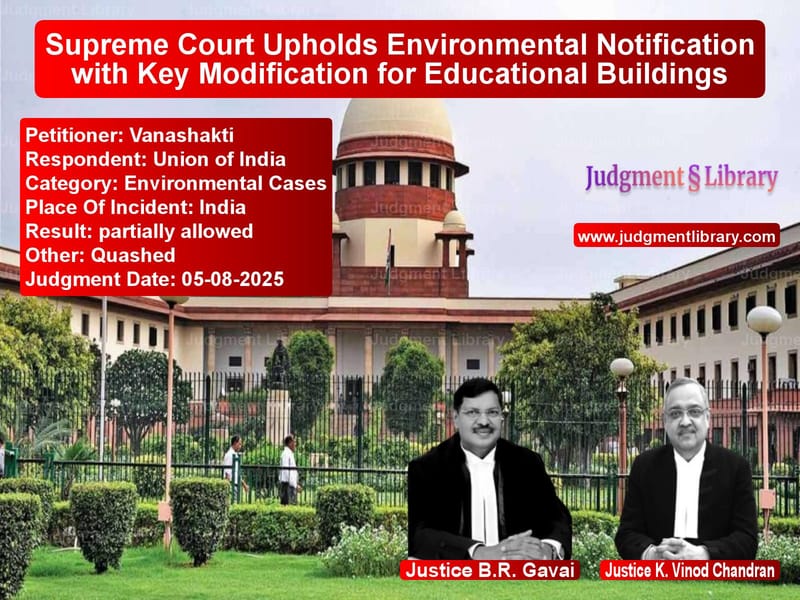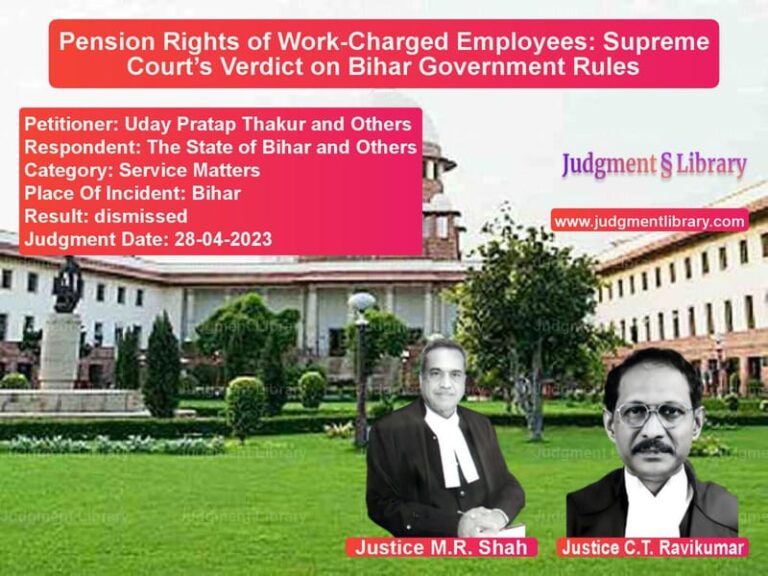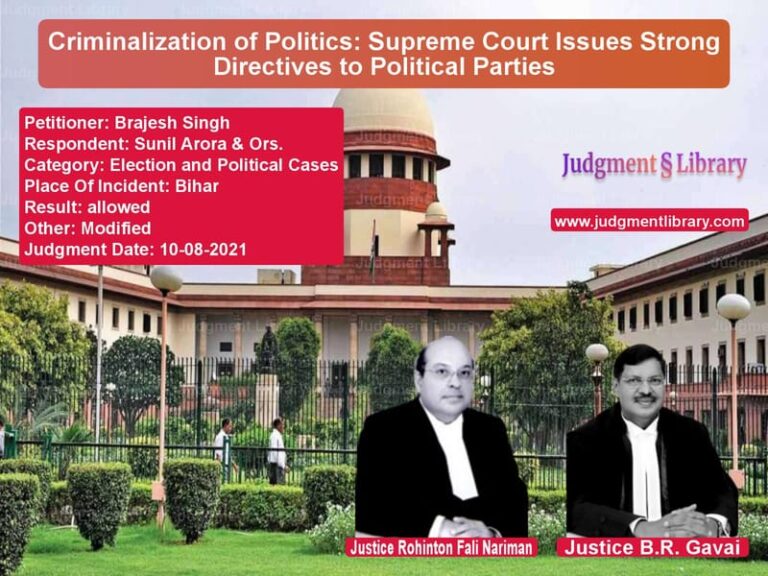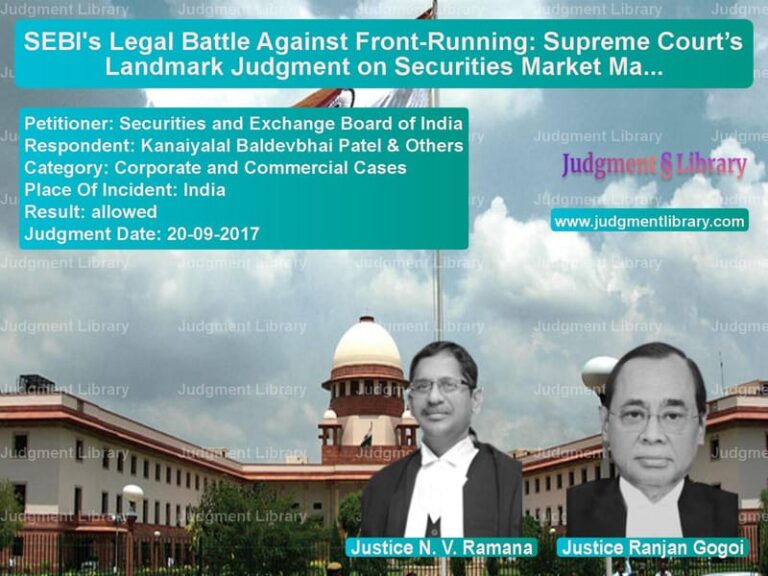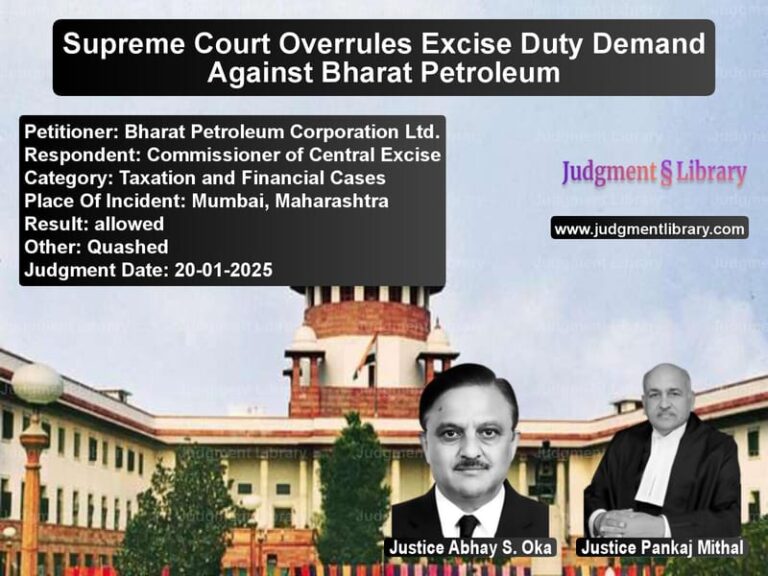Supreme Court Upholds Environmental Notification with Key Modification for Educational Buildings
The Supreme Court of India recently delivered a landmark judgment that strikes a delicate balance between environmental protection and developmental needs. The case involved Vanashakti, an environmental organization, challenging a notification issued by the Ministry of Environment, Forest and Climate Change that they argued would dilute environmental protections for construction projects across the country.
The legal battle centered around Notification S.O. 523(E) dated January 29, 2025, and an accompanying Office Memorandum dated January 30, 2025. Vanashakti, represented by senior counsel Shri Gopal Sankaranarayanan, argued that these documents fundamentally changed the environmental clearance regime that had been established by a 2006 notification.
Shri Sankaranarayanan made several compelling arguments before the court. He stated that “the Union of India has been making consistent efforts to dilute the provisions contained in the 2006 notification” through successive notifications in 2014, 2016, and 2018. He pointed out that previous attempts had been struck down by various courts – the 2014 notification was quashed by the Kerala High Court, the 2016 notification was set aside by the National Green Tribunal, and the 2018 notification had been stayed by the Delhi High Court.
The petitioner’s counsel emphasized that “the preamble of the 2025 notification does not refer to the judgment of the learned NGT and the order of the Delhi High Court” and therefore suffered from suppression of material facts. He argued that under the original 2006 framework, projects within 10 kilometers (later reduced to 5 kilometers) of protected areas, critically polluted zones, eco-sensitive areas, and inter-state boundaries had to be examined directly by the central ministry rather than state-level authorities.
Shri Sankaranarayanan contended that “having failed in its repeated attempts to dilute the restrictions as provided in 2006 notification, the MoEF&CC has come with the impugned notification which has the effect of nullifying the judgments passed by the High Court of Kerala and the NGT.” He also requested the court to await a pending judgment from another bench hearing a related matter to avoid conflicting decisions.
On the other side, the Union of India, represented by Additional Solicitor General Ms. Aishwarya Bhati, presented a different perspective. She argued that “right from inception, the General Conditions were never made applicable to the projects or activities covered by Entry 8 of the Schedule.” She pointed to the specific language of the 2006 notification, noting that wherever the legislation intended General Conditions to apply, it explicitly stated so in the fifth column of the schedule.
Ms. Bhati explained that the 2025 notification was issued “to bring clarity and in view of some of the orders passed by the learned NGT which required the notification to be issued after following the procedure prescribed by law.” She emphasized the practical challenges, stating that “MoEF&CC is not equipped with the machinery to consider the entire projects from all the State/Union Territories in the country” and that the 2006 notification itself provided for projects to be considered by State-level authorities.
Other senior counsel supporting the government’s position, including Shri Mukul Rohatgi and Shri Atmaram Nadkarni, highlighted the real-world impact of the legal uncertainty. Shri Nadkarni revealed that “in Maharashtra alone 700 projects are pending consideration before SEIAA, which, on account of stay order granted by this Court could not be considered.” They argued that the stay on the notification had “caused irreparable damage to the developmental activities throughout the country.”
The Supreme Court, in its analysis led by Chief Justice B.R. Gavai, delved deep into the technical aspects of the various notifications. The court examined the schedule of the 2006 notification and observed that “wherever the delegated legislation required the General Conditions should be applied, the notification specifically provided for the same.” The court noted that “Entry 8(a) and 8(b) of the Schedule do not provide for applicability of General Conditions” from the very beginning.
The court addressed the petitioner’s concerns about previous court decisions, noting that the NGT had primarily dealt with different aspects of the notifications, particularly the establishment of Environmental Cells at municipal levels, which the court distinguished from the statutory SEIAA bodies. The court stated that “the Environmental Cell at the level of a municipal body cannot be equated with SEIAA, which is a statutory body constituted by the Central Government under a statute namely the Environment (Protection) Act, 1986.”
In a crucial part of its reasoning, the court emphasized the principle of sustainable development. The judgment extensively referenced previous decisions, noting that “the courts have taken a view that while development is permitted to be undertaken, it is also required that a precaution is needed to be taken so that the least damage is caused to the environment and ecology.”
The court reproduced important passages from its earlier judgments, including this significant observation: “The traditional concept that development and ecology are opposed to each other is no longer acceptable. ‘Sustainable Development’ is the answer.” The court further quoted: “‘Sustainable Development’ as defined by the Brundtland Report means ‘Development that meets the needs of the present without compromising the ability of the future generations to meet their own needs’. We have no hesitation in holding that ‘Sustainable Development’ as a balancing concept between ecology and development has been accepted as a part of the customary international law.”
The court agreed with the government’s practical concerns, stating “We are in agreement” that it’s not possible for the central ministry to handle all projects nationwide. The court expressed confidence in the SEIAA system, noting that “the SEIAA is a body of experts constituted/appointed by the Central Government itself and it is better equipped to undertake study qua environmental impact of proposed projects in the respective state/union territory.”
However, the court identified one problematic aspect of the 2025 notification – the exemption for industrial sheds, schools, colleges, and hostels from environmental impact assessment requirements. The court strongly objected to this exemption, stating “It cannot be gainsaid that if any construction activity for an area of more than 20,000 sq. mtr. is to be carried out, it will naturally have an effect on the environment and ecology, even if the building is for industrial shed or for educational purpose, including hostels etc.”
The court made a particularly significant observation about the education sector: “It is by now common knowledge that education is no more exclusively a service oriented activity and that it has in fact become a flourishing and thriving industry.” The court found “no reason to discriminate the other buildings with the buildings constructed for industrial or educational purposes” and noted the absence of any “rational nexus with the object to be achieved by excluding such buildings from the rigors of the notification.”
In its final ruling, the court partially allowed the writ petition. It upheld the January 29, 2025 notification but struck down Note 1 to Entry 8(a), which had exempted industrial and educational buildings from environmental clearance requirements. The court also upheld the Office Memorandum that extended the notification’s application to Kerala state.
This judgment represents a nuanced approach to environmental governance – recognizing the need for streamlined processes to facilitate development while ensuring that no category of construction activity escapes environmental scrutiny entirely. The court’s decision to remove the exemption for educational and industrial buildings demonstrates its commitment to ensuring that environmental protections apply equally across all sectors, regardless of their stated purpose.
The ruling provides much-needed clarity for hundreds of stalled projects across India while maintaining essential environmental safeguards. It reinforces the principle that sustainable development requires balancing ecological concerns with economic growth, and that specialized state-level bodies are competent to handle environmental assessments for most construction projects, provided they adhere to established standards and procedures.
Petitioner Name: Vanashakti.Respondent Name: Union of India.Judgment By: Justice B.R. Gavai, Justice K. Vinod Chandran.Place Of Incident: India.Judgment Date: 05-08-2025.Result: partially allowed.
Don’t miss out on the full details! Download the complete judgment in PDF format below and gain valuable insights instantly!
Download Judgment: vanashakti-vs-union-of-india-supreme-court-of-india-judgment-dated-05-08-2025.pdf
Directly Download Judgment: Directly download this Judgment
See all petitions in Environmental Cases
See all petitions in Judgment by B R Gavai
See all petitions in Judgment by K. Vinod Chandran
See all petitions in partially allowed
See all petitions in Quashed
See all petitions in supreme court of India judgments August 2025
See all petitions in 2025 judgments
See all posts in Environmental Cases Category
See all allowed petitions in Environmental Cases Category
See all Dismissed petitions in Environmental Cases Category
See all partially allowed petitions in Environmental Cases Category

